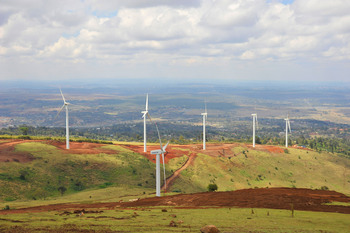Promotion of grid-connected renewable energy, focusing on wind energy
Project description
Project title: Promotion of grid-connected renewable energy, focusing on wind energy, within the scope of the German Climate and Technology Initiative (DKTI)
Commissioned by: German Federal Ministry for Economic Cooperation and Development (BMZ)
Country: Kenya
Lead executing agency: Ministry of Energy and Petroleum; Energy Regulatory Commission
Overall term: 2016 to 2020
Context
The Kenyan Government has identified the availability of adequate, reliable and affordable electricity as a key factor towards driving further economic development. Accordingly, the Government aims to achieve a sixfold increase in the national electricity capacity between 2014 and 2024, from approximately 2,000 megawatts to over 12,000 megawatts. Most of the proposed expansion is based on coal, gas and geothermal generation. Variable renewable energy (VRE) in the form of wind only plays a minor role in the national development plans, while solar power is totally neglected – despite the considerable natural potential.
The resource-conserving expansion of wind and solar energy could substitute the planned climate-damaging use of coal, diesel and gas, and therefore make a crucial contribution to reducing greenhouse gas emissions. An increased share of VRE would lower power generation costs, thus simultaneously increasing the country’s competitiveness.
There is currently a dearth of information on how incentives, technical regulations and other general conditions can be shaped in a targeted manner and subsequently managed so that the increase in VRE can proceed optimally for the economy as a whole, and the electricity grids are not overloaded.

Objective
Conditions for the system-friendly and cost-efficient integration of variable renewable energy in the electricity grid are improved, with the goal of increasing the proportion of wind and solar energy in the power supply.
Approach
The project offers advisory support on improving the conditions for investment in future VRE. It aims to enhance the technical and methodological capacity of state actors.
For this purpose, the project is engaging in four spheres of activity:
- Energy policy: State actors are provided with support on assessing specific VRE data and strategies, and translating these into policy recommendations.
- Energy planning: Support is given to stakeholders to improve their planning and modelling skills as well as to help them analyse the economic benefits in addition to the limitations involved in integrating VRE.
- Regulation: The state regulatory body is familiarised with the specific costs, benefits and investment risks associated with VRE as well as the fundamentals of internationally proven regulatory approaches.
- Technical implementation: The technical expertise of wind farm and solar park developers and operators as well as the grid operator is developed further and coordination among these parties is improved.
The project’s target group consists of grid-connected energy users and ultimately the entire population, which stands to benefit from the availability of a reliable, low-cost and environmentally friendly energy supply to the Kenyan economy.
KfW Development Bank is cofinancing Kenya’s second largest wind power project, the Meru wind farm. Lessons learned from this financing arrangement are feeding into the project’s advisory services on improving the conditions for future investment in VRE.